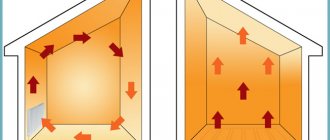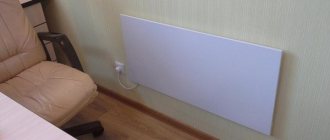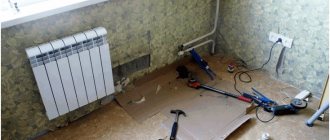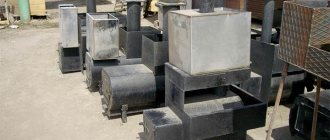In many apartments, a balcony or loggia serves as a dumping ground for all kinds of garbage, jars of pickles, and sports equipment. This happens because it is simply impossible to stay there in winter. If you save on insulating your balcony, then in the cold season the temperature on it can drop below 0 degrees.
Making a loggia into a full-fledged living space does not cost a lot of money or effort. To do this, it is not necessary to carry out a full renovation. But if possible, you need to think about heating a balcony or loggia already at the construction stage.
Insulation of the loggia during the construction phase
The tips in this section are suitable for “bare” balconies and loggias. The main difference between these two rooms is that the balcony protrudes from the facade of the house, and the loggia is separated from the main room by a wall. Read more in the article “What is the difference between a loggia and a balcony?”
The first thing you should decide is whether you are ready to start insulating the outside. This may require special equipment if you live above the 1st floor. Double-sided insulation is necessary for large rooms.
Seal all cracks with sealant (small) or foam (large). Heat escapes through them the fastest. Level all walls with putty and cement mortar. This increases the efficiency of thermal insulation.
Pay special attention to moisture insulation. Dampness attracts cold. Treat the internal and external walls with a moisture-repellent solution before installing heat-insulating panels.
A carbon heater, in our opinion, is the best tool for this purpose.
These products come in lamp, rod and film types. In the first two cases, carbon filaments enclosed in the airless space of the lamp body or rod act as a heating element.
In the film, such functions are performed by carbon paste, evenly distributed between two layers of dense polymer.
Carbon (carbon) has thermal conductivity that is several times greater than that of other materials. At the same time, it offers the least resistance to electric current.
Based on such characteristics, it can be understood that the energy consumption of such devices is minimal.
According to their main design features, IR heaters are divided into several types:
- ceiling;
- wall-mounted (both lamp and film);
- floor
All designs have their own individual sizes and shapes, but the essence of the device is always the same - the emission of infrared rays.
What are IR rays
The rays have practically no characteristics that have a detrimental effect on the human body, animals or plant structure. They do not create vibrations, noise, or burn oxygen the way other types of heaters do, but only create small electromagnetic radiation.
IR radiation does not heat the surrounding air, but when it acts on objects, it heats them up, if, of course, they are in the zone of its propagation.
It is also worth remembering the property of IR rays, which is their wavelength (9.4 microns), which completely coincides with the range of thermal radiation of the human body, or rather, the wavelength of this range (8–10 microns). This indicator is natural for a person, and this contributes to a powerful healing effect.
Many people call infrared radiation in this range “life rays.” Tested and recorded in laboratory conditions - during operation of an infrared device, molecules (so-called anions) are formed in the air. Anions are a kind of “air vitamins”; they cleanse the air of foreign odors and have a positive effect on humans, animals and vegetation from all sides.
Compared to other types of heaters, infrared heaters will save you at least 15-20% on energy consumption. And if you install a programmable thermostat, the savings will be at least 25–35%.
Which option to choose
Before you go shopping, you need to decide on the location of the heating device. I have already mentioned above that household infrared heaters can be placed on the ceiling, wall or floor.
The design features of the devices do not in any way change the main purpose, so first of all pay attention to the power of the heating element and the design of the heater in general
The power directly determines whether the device can heat the entire area of the room or not, but the design, I think, is a personal matter.
So, let's see what different types of heaters look like:
Infrared ceiling heater
The design of such devices varies, but, as a rule, does not differ much from the basic model. As a rule, this is a flat panel, rectangular in appearance, with brackets for mounting on the ceiling on the balcony. The panels have a variety of sizes, and the choice of color scheme can please any housewife.
Infrared wall heater
Here, the imagination of manufacturers led to the fact that, in addition to traditional-looking devices, heaters appeared in the form of a picture, for example. An infrared film heater is located behind the surface of the painting. Beautiful and practical. In addition, such a picture, with an area of 0.5 square meters, is quite enough to heat a small balcony.
Infrared floor heater
This type of device has the widest range of models.
Models can be vertical or horizontal, thick or thin. They come in a chrome-plated or polymer-painted body, or the “filling” is enclosed in a ceramic base.
When choosing a floor-standing option, it is necessary to correlate the area of the heated room with the power of the device, since some are so small that they cannot heat the entire room.
Film infrared heaters
There is also a variety of heaters made of carbon film. Infrared film heaters can look like a picture, for example. A heater with artistic design will fit perfectly into the interior of the balcony and decorate it.
Insulating materials
The following types of insulation are available on the market:
- expanded clay;
- mineral wool;
- expanded polystyrene;
- polyurethane foam;
- penofol.
Choosing the optimal material is easier than it seems.
Expanded clay
This is the cheapest material. Does not hold its shape, readily absorbs moisture. Durable, resistant to fire, mold, mildew. It is used to insulate the floor on the balcony when they want to save money.
Insulating the floor on the loggia with expanded clay
Mineral wool
Medium price material. Its slabs are very wide, so they are not suitable for small spaces. The ingress of moisture impairs the insulating properties. Mineral wool is environmentally friendly, fire-resistant, and creates additional sound insulation.
Balcony insulation with mineral wool
Expanded polystyrene
Expensive insulation, devoid of any shortcomings. The plates are easily attached to any surface using self-tapping screws. The best option for any room.
Polyurethane foam
Liquid insulation. Easily fills any cracks and cavities. Special equipment is required for installation. Dismantling presents some difficulties.
Penofol
Auxiliary thin heat and water insulator. It is used together with expanded polystyrene and mineral wool to create an additional air layer.
After you have chosen a thermal insulator, proceed with installation. First, all walls, floor, and ceiling must be covered with a layer of waterproofing made of polyethylene or foam foam, and the joints between the sheets must be glued with tape.
Balcony insulation with penofol
Then a metal or wooden frame is built (for more details, see the article “balcony sheathing”), into which the insulation will then be laid. The distance between it and the surfaces must be sealed with polyurethane foam. Next, the insulating boards are tightly laid. There should be no gap between them and the frame, otherwise all the work will go down the drain.
A rough covering of chipboard and plywood is built on top of this structure. You can install a heated floor on the loggia. Then finishing work is carried out.
Good double-glazed windows - warm balconies
When choosing PVC windows, the main criterion is the number of hollow chambers; in the standard set there are from three to five. They prevent cold from entering; accordingly, the greater their number, the better the windows retain heat. Special plastic systems should be used for equipment. Glazing with this type of windows instead of traditional ones will reduce heat loss in your home by as much as 30%, and prevent drafts and dust. This design, made using new Austrian technologies, will help make glass cuts for balconies with complex shapes.
Do-it-yourself insulation of a balcony
If you don’t have time to do a full-fledged balcony repair with your own hands, use some folk methods of insulating a loggia. The temperature may rise by several degrees. Remember that this is a temporary measure. Such “tricks” cannot replace full thermal insulation.
Walk around the loggia with a candle or lighter. This will help determine from which joints and cracks the air is blowing. Seal them with putty. Draft is the worst enemy of heat.
Construct insulating panels from scrap pieces of foam. This material conducts heat poorly.
Such improvised insulation can be done in a few hours, but even this little thing reduces the chance of catching a cold from the cold coming from the loggia.
No. 3. Warm glazing options
To organize warm glazing, systems with the following types of profiles are used:
- plastic (PVC) - the most popular, affordable and versatile option;
- a wooden profile is approximately the same in terms of heat and noise insulation as a plastic one, but is distinguished by its chic appearance and environmental friendliness, and you will have to pay extra for this;
- warm aluminum is used a little less often, although in some performance qualities it outperforms plastic and wood.
Differences may also lie in the characteristics of the glass unit and in the system for opening the sashes. In addition, you can make the system more functional using various kinds of accessories.
Central heating radiators
Previously, it was possible to bring the central heating radiator onto the balcony without any problems. It was not forbidden to do the installation yourself. But now such actions are an administrative article.
The government has decided to limit the ability of residents of apartment buildings to change the layout of heating systems. This was done for security reasons. The battery on the loggia may freeze and burst.
Having an experienced lawyer and observing all the regulations, such redevelopment can be legalized through the court. This takes time and money, but as a result you get full heating of the loggia.
Advantages of a warm loggia
- A good option for a small apartment. Expanding space is the main goal of remodeling a room. Connecting the balcony and living space will allow you to create another room, albeit a small one. Here you can create a study, workshop or flower garden.
- High insulation. Insulation allows you to spend more time on the balcony or convert it into an additional room. External noise is noticeably muffled, in winter the heat does not escape to the street, and the temperature on the loggia and throughout the apartment is almost the same.
- Good functionality. A cold balcony is only suitable for storing unnecessary things that are rarely useful in everyday life. You can organize summer gatherings, but in cold weather it is not possible to be in the loggia. Insulation will solve this problem and allow you to use the balcony as a full-fledged room in the apartment.
- Various design options. An insulated loggia is an additional room in the house. It can be decorated according to personal preferences, like any other room. It is advisable to create a general design for the apartment and balcony so that the composition is one whole.
- Reducing the risk of fire. A lot of trash and old things are stored on the unequipped balcony. All this can cause a fire. Despite the fact that service workers warn people about possible danger, rarely does anyone listen to the rules. An insulated loggia is a full-fledged room, so unnecessary things that could cause a fire will not accumulate on it.
Water floor heating
The water heating system is a polymer tube that is installed under the screed. It can be connected to both a gas boiler and a central heating system.
Don't forget to check the water heating on the balcony before screeding it. This can save you from paying compensation to your flooded neighbors.
Advantages - low price.
Flaws:
- damage to the tube can lead to a flood;
- fragility;
- Difficult to connect to central heating system.
Conclusion: a budget balcony heating system, which makes sense to install if you have an economical gas boiler.
No. 6. Opening type
Warm glazing cannot be frameless, i.e. it will consist of several doors. As a rule, some of these sashes remain blind - this design is cheaper. Several doors must be opening, otherwise there will simply be a greenhouse on the balcony. The opening mechanism may be different:
- a rotating sash is the simplest option, allowing you to fully open the sash, letting in as much air as possible. In addition, the sash can be washed on both sides, and you can even reach the adjacent blinds to put them in order. The downside is that it is impossible to open the window just slightly for ventilation, but for this purpose you can use special combs that allow you to fix the sash at a certain angle;
- The flap is fixed and can be tilted to a certain angle into the room. It can be used to ventilate, but in terms of glass care this design is quite complicated;
- the tilt-and-turn design is more expensive, but at the same time it is as functional as possible;
- A transom is something like the good old vents; only the upper part of the sash is folded back, the lower part remains blank.
Sliding windows and warm glazing are incompatible things.
Electric floor heating
Electric balcony heating is more expensive and more reliable than water heating. Installation is almost no different from water systems. The only difference is that the electric floor must be connected to the power supply.
Advantages:
- durability;
- simple installation;
- precise temperature control.
Flaws:
- high price;
- needs stable mains voltage;
Conclusion: a durable system for apartments and small suburban premises.
There are two types of electric heated floors on the balcony:
- cable;
- infrared.
The latter type is more modern, but it is not without its drawbacks.
Cable electric heating
The heating element of such a system is a single- or two-core wire that has two layers of insulation. Cable heating on the balcony is not very economical.
Infrared electric heating
Thin thermal films of an infrared heating system consist of strips of graphite, isolated from each other and from the environment. This heating is 20% more economical than cable analogues, it is completely safe, but its service life is no more than 15 years.
Infrared film floor
The heating of balconies insulated by us is successfully handled by an electric heated film floor. We insulate the balcony carefully, so other heat sources are no longer needed. Neither convectors nor fan heaters. One floor is enough in the coldest weather.
Moreover, it warms where it is most needed. If your feet don't get cold, the rest of the person doesn't get cold either)
Cost of heated floors for a balcony
The cost of a set of heated floors for a medium-sized loggia, for example, in a house of the 97th series, is 4,500 rubles. The kit includes: thermostat, heating film and reflective thermal insulation.
Power consumed by film flooring
About 200 watts per 1 square meter. The operation of the floor is controlled by a thermostat, which turns off the heating film when the set air temperature in the room is reached. In fact, the floor consumes energy no more than half the time. Of course, power consumption greatly depends on the area of the window on the parapet. The larger it is, the higher the cost of heating the room. Therefore, we strongly advise customers to reduce its glazing area to reasonable limits. Why leave glass where there will be a closet, for example?
Installation of heated floors on a heated balcony
We make insulated floors of our own design on balconies covered with thick-sheet plywood. The thickness of the floor “pie” is at least 120 mm. It is durable, warm and will never squeak. Reflective thermal insulation made of 3 mm thick polyethylene foam is laid on top of the plywood. On top of it is the infrared film itself of the area that is needed. That's it - after this you can lay the flooring. The operation of the floor is controlled by a thermostat, which we install in a convenient location. Typically this is next to the light switch on the balcony.
In order not to lay a temporary coating during the final puttying and wallpapering, we completely assemble the electrical part, check it, but roll the floor itself again into a small roll. It does not interfere during finishing, and before laying the flooring you only need to cut the tape and level the film.
And of course, don’t forget to place a “reflector” under it with the shiny side up. Which we also leave in a roll with a reserve area. This job takes a few minutes. But, of course, we can roll out everything right away if the customer has temporary covering, for example, old linoleum from a balcony.
Durability and safety
Most of the heating film market in Russia belongs to Korean manufacturers. It does not burn and does not emit odor when heated, and is mechanically durable. The manufacturer guarantees trouble-free operation for 25 years. In fact, much longer. Even if the warm floor is covered with pillows, the most that can happen is the destruction of the carbon bridges inside the film itself. As a result, only a small part of the floor will stop heating, the rest of the floor will function normally. However, such experiments should not be carried out.
To prevent overheating of the floor, do not place bulky items on the floor, for example, a large bag or mattress. Also, you cannot install a floor under furniture with a blank apron at the bottom instead of legs. On legs or with a narrow support - please. Any place and any furniture.
The sad stories about women's shoes with heels that are told on the Internet are simply myths. This will prevent damage to the floor through the flooring. Even nails that penetrate it do not disable it. Unless the tester gets an electric shock. And even then not much.
Warm Balcony, 2016
Heating with electric appliances
If you were able to insulate your balcony, but you don’t have enough time or money to install a heating system, use heaters. Understanding all the variety of these devices can be difficult. Let's look at each of them in more detail.
Fan heater
A fan heater is an inexpensive option for auxiliary or spot heating on a loggia.
It consists of:
- housings;
- heating element;
- heat dissipation systems.
The body can be made of plastic or metal. After prolonged use, the plastic may burn and melt in some places. This does not affect the operation of the device, but still you should not spare money on purchasing a high-quality heater.
The key part of an electric fan heater is the heating element.
Main types:
- Spiral made of nichrome wire. It is used in the cheapest devices. It has a high temperature and very low heat transfer.
- Tubular heating element. A metal tube filled with a heat-conducting substance. It has average heating and heat transfer rates.
- Ceramic. Semiconductor heating element coated with glass ceramics. Has the highest heat transfer parameters.
For a small room, floor-mounted stationary or mobile fan heaters in a metal casing are suitable.
Convector for the balcony
A convector is a thermal panel, an automatic heater that gradually changes the temperature in the room. Cold air enters the housing, heats up, and then is blown back out. The heating element does not heat up above 100 degrees, which reduces the likelihood of fire in surrounding objects to a minimum.
The thermal panel may have the following heaters:
- Electric. Nichrome spiral, tubular electric heater, infrared element. Expensive models are characterized by increased efficiency and reduced energy consumption.
- Gas. Economical, but requires connection to a gas cylinder and a central gas pipeline.
A convection heater should be used to maintain a constant temperature on the balcony.
Oil radiator
An oil heater resembles a regular water battery, but works much more efficiently.
It consists of:
- metal radiator;
- mineral oil with high thermal conductivity;
- tubular electric heater;
- temperature and power control systems.
Radiators come in two types:
- panel;
- sectional.
Always choose a sectional oil cooler. This design has an increased area of contact with the surrounding air. There are mobile and stationary models. Choose equipment depending on the size of the balcony.
What to consider when choosing a device
Choosing a heater for a balcony or loggia has some nuances. They relate to both the device itself and the features of the room.
If your balcony is used as:
- pantry for vegetables, canned food, preparations - you need a temperature of about 3-5 ° C , that is, simple insulation of the balcony without installing a heating system is enough;
- a work office, a sports corner, a place for hobbies or growing a mini-garden - periodic heating of the room or the temperature required for specific plants is suitable;
- permanent living space or space attached to a room - the temperature should be constant, within 20-25°C .
In cases where the balcony is glazed, but unnecessary or seasonal items are simply stored on it, laundry is dried, etc., it makes no sense to install special heaters.
Another important aspect is the area of the balcony. If it is small and not filled with furniture, one heating device on the ceiling or a regular fan heater will be enough. If you have a spacious loggia at your disposal, you can think about organizing a heated floor system.
The operating features of a particular heater are also important to consider. As mentioned above, there is no need to install heating radiators on a balcony that you rarely use.











